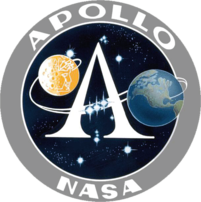Apollo 7
| Apollo 7 | |||||
|---|---|---|---|---|---|
Mission insignia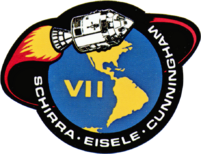 |
|||||
| Mission statistics | |||||
| Mission name | Apollo 7 | ||||
| Command Module | CM-101 | ||||
| Service Module | SM-101 | ||||
| Spacecraft mass | 36,419 pounds (16,519 kg)[1] | ||||
| Crew size | 3 | ||||
| Booster | Saturn IB SA-205 | ||||
| Launch pad | LC-34 Cape Canaveral AFS Florida, U.S. |
||||
| Launch date | October 11, 1968 15:02:45 UTC |
||||
| Landing | October 22, 1968 11:11:48 UTC |
||||
| Mission duration | 10 d 20 h 09 m 03 s | ||||
| Number of orbits | 163 | ||||
| Apogee | 160 nautical miles (300 km) | ||||
| Perigee | 125 nautical miles (232 km) | ||||
| Orbital period | 89.78 m | ||||
| Orbital inclination | 31.63° | ||||
| Crew photo | |||||
.jpg) |
|||||
| Left to right: Eisele, Schirra, Cunningham | |||||
| Related missions | |||||
|
|||||
Apollo 7 (October 11-22, 1968) was the first manned mission of Project Apollo, and the first manned US space mission launched after the cabin fire which killed the crew of what was to have been the first manned mission, Apollo 204 (also renamed Apollo 1), on January 27, 1967. It was a C type mission - an eleven-day Earth-orbital mission, the first manned launch of the Saturn IB launch vehicle, and the first three-person American space mission. The crew consisted of Mission Commander Walter M. Schirra, Command Module Pilot Donn F. Eisele, and Lunar Module Pilot R. Walter Cunningham.
The mission was the first manned test of the redesigned Block II Apollo Command/Service Module. It flew in Earth orbit so the crew could check life-support, propulsion, and control systems.[2] Despite tension between the crew and ground controllers, the mission was a technical success, which gave NASA the confidence to launch Apollo 8 around the moon just two months later. However, the flight would prove to be the last space flight for all of its three crew members. It was also the final manned launch from Cape Canaveral, Florida.
Contents |
Crew
| Position | Astronaut | |
|---|---|---|
| Commander | Walter M. Schirra Third spaceflight |
|
| Command Module Pilot | Donn F. Eisele First spaceflight |
|
| Lunar Module Pilot | R. Walter Cunningham First spaceflight |
|
| This crew was originally the backup crew for Apollo 1. | ||
Backup crew
| Position | Astronaut | |
|---|---|---|
| Commander | Thomas P. Stafford | |
| Command Module Pilot | John W. Young | |
| Lunar Module Pilot | Eugene Cernan | |
| This crew flew on Apollo 10. | ||
Support crew
- Ronald E. Evans, Jr
- Edward G. Givens, Jr
- John L. Swigert, Jr
- William R. Pogue
Flight directors
- Glynn Lunney (Lead), Black Team
- Gene Kranz, White Team
- Gerry Griffin, Gold Team
Mission highlights
Apollo 7 was a test flight, and confidence-builder. After the January 1967 Apollo launch pad fire, the Apollo Command Module had been extensively redesigned. Schirra, who would be the only astronaut to fly Mercury, Gemini and Apollo missions, commanded this Earth-orbital shakedown of the Command and Service Modules. Since it was not carrying a Lunar Module and only needed to reach a low earth orbit, Apollo 7 could be launched with the Saturn IB booster rather than the much larger and more powerful Saturn V. Schirra wanted to name the Apollo 7 Command module "Phoenix" (the mythical bird rising from its own ashes) in memory of the late Apollo 1 crew, but NASA management rejected the idea.
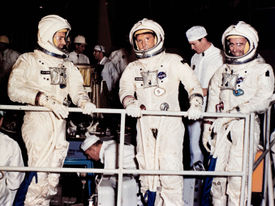
Throughout the Mercury and Gemini programs, McDonnell Aircraft engineer Guenter Wendt had been leader of the spacecraft launch pad teams, with ultimate responsibility for condition of the spacecraft at launch. He had come to be respected and admired by all the astronauts, including Schirra. But since the Apollo contractor had been changed from McDonnell to North American Rockwell, Wendt had not been pad leader for Apollo 1.
So adamant was Schirra in his desire to have Wendt back as Pad Leader for his Apollo flight, that he got his boss Deke Slayton to persuade North American management to hire Wendt away from McDonnell, and Schirra personally lobbied North American's launch operations manager to change Wendt's shift from midnight to day so he could be pad leader for Apollo 7. So Wendt remained as Pad Leader for the entire Apollo program.[3]
Wendt's face was the last they saw before the hatch was sealed, and immediately after liftoff Eisele said with a mock German accent into his radio, "I vonder vere Guenter Vendt?"
The Apollo hardware and all mission operations worked without any significant problems, and the Service Propulsion System (SPS), the all-important engine that would place Apollo into and out of lunar orbit, made eight nearly perfect firings.
Even though Apollo's larger cabin was more comfortable than Gemini's, eleven days in orbit took its toll on the astronauts. Tension with Commander Schirra began with the launch decision, when flight managers decided to launch with a less than ideal abort option for the early part of the ascent. Once in orbit, the spacious cabin may have induced some crew motion sickness, which had not been an issue in the earlier, smaller spacecraft. The crew was also unhappy with their food selections. But the worst problem occurred when Schirra developed a severe head cold. As a result, he became irritable with requests from Mission Control and all three astronauts began "talking back" to the Capcom. An early example was this exchange after Mission Control requested that a TV camera be turned on in the spacecraft:
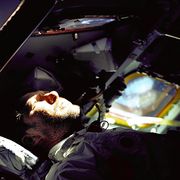
SCHIRRA: You've added two burns to this flight schedule, and you've added a urine water dump; and we have a new vehicle up here, and I can tell you at this point TV will be delayed without any further discussion until after the rendezvous.
CAPCOM: Roger. Copy.
SCHIRRA: Roger.
CAPCOM: Apollo 7 This is CAP COM number 1.
SCHIRRA: Roger.
CAPCOM: All we've agreed to do on this is flip it.
SCHIRRA: ... with two commanders, Apollo 7
CAPCOM: All we have agreed to on this particular pass is to flip the switch on. No other activity is associated with TV; I think we are still obligated to do that.
SCHIRRA: We do not have the equipment out; we have not had an opportunity to follow setting; we have not eaten at this point. At this point, I have a cold. I refuse to foul up our time lines this way.[4]
Exchanges such as this led to all three Apollo 7 crew members being rejected for future missions.[5] Despite these difficulties, the mission demonstrated the space-worthiness of the Apollo Command and Service modules, which led to the decision to launch Apollo 8 to the moon just two months later.
Beyond a shakedown of the spacecraft, goals for the mission included the first live television broadcast from an American spacecraft (Gordon Cooper had broadcast slow scan television pictures from Faith 7 in 1963) and testing the mock LM docking maneuver which involved rendezvous with the launch vehicle's discarded upper stage (referred to by Schirra in the above conversation.)
The splashdown point was 27 deg 32 min N, 64 deg 04 min W, 200 nautical miles (370 km) SSW of Bermuda and 7 nmi (13 km) north of the recovery ship USS Essex.
Apollo 7 was the only manned Apollo launch to take place from Cape Canaveral Air Force Station's Launch Complex 34, as all subsequent Apollo and Skylab missions (including Apollo-Soyuz) were launched from Launch Complex 39 at the nearby Kennedy Space Center.
As of 2010, Cunningham is the only surviving member of the crew. Eisele died in 1987 and Schirra in 2007.
Belated recognition
In October 2008, NASA administrator Michael D. Griffin awarded the crew of Apollo 7 NASA's Distinguished Service Medal, in recognition of their crucial contribution to the Apollo Program. They had been the only Apollo and Skylab crew not granted this award. Cunningham was present to accept the medal, as were representatives of his deceased crew members, and other Apollo astronauts including Neil Armstrong, Bill Anders, and Alan Bean. Former Mission Control Flight Director Chris Kraft, who was in conflict with the crew during the mission, also sent a conciliatory video message of congratulations, saying: "We gave you a hard time once but you certainly survived that and have done extremely well since...I am frankly, very proud to call you a friend."
Mission insignia
The insignia for the flight showed a Command and Service module with its SPS engine firing, the trail from that fire encircling a globe and extending past the edges of the patch symbolizing the Earth-orbital nature of the mission. The Roman numeral VII appears in the South Pacific Ocean and the crew's names appear on a wide black arc at the bottom. The patch was designed by Allen Stevens of Rockwell International.[6]
Spacecraft location

In January 1969, the Apollo 7 Command Module was displayed on a NASA float in the inauguration parade of President Richard M. Nixon. For nearly 30 years the Command Module was on loan (renewable every two years) to the National Museum of Science and Technology, in Ottawa, Ontario, along with the space suit worn by Wally Schirra. In November 2003 the Smithsonian Institution in Washington D.C. requested them back for display at their new annex at the Steven F. Udvar-Hazy Center. Currently, the Apollo 7 CM is on loan to the Frontiers of Flight Museum located next to Love Field in Dallas, Texas.
Depiction in entertainment
Portions of the Apollo 7 mission are dramatized in the miniseries From the Earth to the Moon episode entitled "We Have Cleared the Tower".
Notes
- ↑ "NASA Apollo 7 Mission Report, Dec.1,1968". p. A–47. http://ntrs.nasa.gov/archive/nasa/casi.ntrs.nasa.gov/19760072144_1976072144.pdf.
- ↑ "1968 in Space; 1968 Year in Review, UPI.com"
- ↑ Farmer, Gene; Dora Jane Hamblin (1970). First On the Moon: A Voyage With Neil Armstrong, Michael Collins and Edwin E. Aldrin, Jr.. Boston: Little, Brown and Co.. pp. 51-54. Library of Congress 76-103950.
- ↑ "Apollo 7 Air-to-Ground Voice Transcriptions". National Aeronautics and Space Administration. pp. 117–118. http://www.jsc.nasa.gov/history/mission_trans/AS07_TEC.PDF. Retrieved 2008-10-24.
- ↑ Wade, Mark. "Apollo 7". Encyclopedia Astronautica. http://www.astronautix.com/flights/apollo7.htm. Retrieved 2008-10-24.
- ↑ Hengeveld, Ed. The Apollo Emblems of Artist Al Stevens. Spaceflight magazine, June 2008, pp. 220-225.
References
- NASA NSSDC Master Catalog
- APOLLO BY THE NUMBERS: A Statistical Reference by Richard W. Orloff (NASA)
- Lattimer, Dick (1985). All We Did was Fly to the Moon. Whispering Eagle Press. ISBN 0-9611228-0-3.
- Schirra, Wally with Richard Billings (1988). Schirra's Space. Naval Institute Press. ISBN 1-55750-792-9.
Gallery
 Apollo 7 launch |
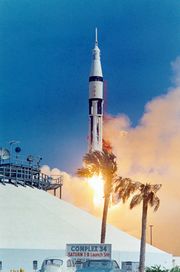 Apollo 7 launch |
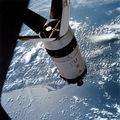 Apollo 7 SIV-B rocket stage |
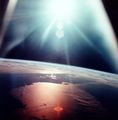 Apollo 7 view of Florida |
 Television transmission from Apollo 7 |
 Crew after recovery aboard USS Essex |
External links
- NASA Apollo 7 press kit - Oct 6, 1968
- NASA Apollo 7 Mission Report - December 1, 1968 (PDF format)
- Apollo 7 entry in Encyclopedia Astronautica
- The Apollo Spacecraft: A Chronology
- Apollo Program Summary Report
- Apollo 7 Launch ApolloTV.net Video
|
||||||||||||||||||||||||||
